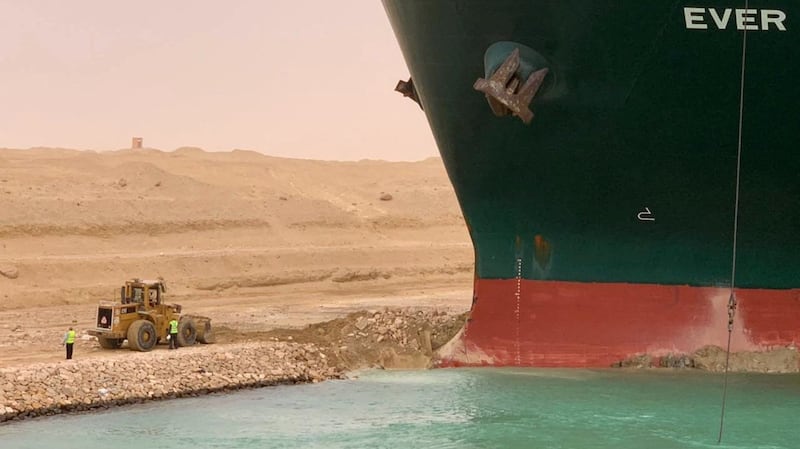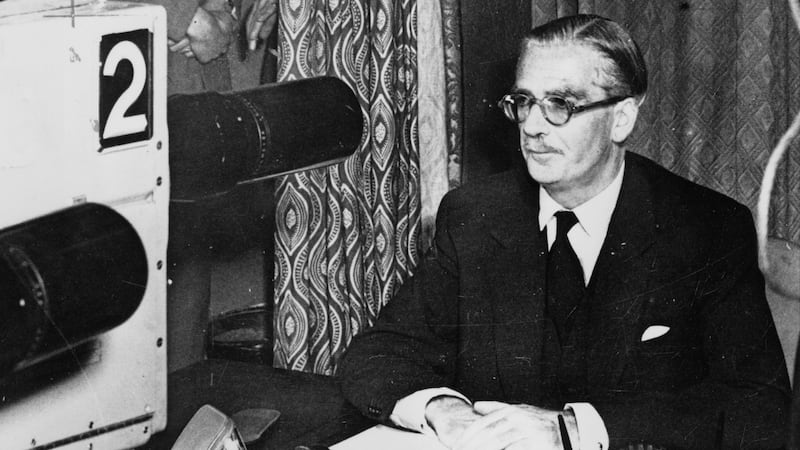Who was not gripped by the unexpected drama of the Suez Canal? One very large ship and a big gust of wind and all of a sudden international shipping was brought to a standstill. Desperate ship captains headed off to take the hard way around the Cape of Good Hope. Images of a little tiny digger next to a huge boat lent themselves to many a David and Goliath meme.
Completed in 1869, the Suez Canal was held up by its developer Ferdinand de Lesseps as another example of human progress during that century of progress: the triumph of human ingenuity (David) over vast unfriendly nature (Goliath). It followed close on the heels of the submarine telegraph cable linking the west of Ireland to the east of North America (1866) and the growth of steam power as a motive force, slowly edging out horse and sail.

As historian Valeska Huber points out in her book Channelling Mobilities, a short cut to the Red Sea had long looked like a tempting link between the Mediterranean world and the trading opportunities of the Indian Ocean. During the 19th century a train route was built, crossing Egypt from the port of Alexandria to Suez.
Caravan across Egypt
From Suez, travellers could take a ship's passage onwards to India. Prior to the railway, the more adventurous traveller could journey by caravan across Egypt, possibly saving time and money by avoiding the trip around the Cape. Adventurers such as Joseph Conrad dismissed the new travellers that Suez enabled to make round-the-world voyages in relative comfort.
The canal hastened the retreat of sailing ships in favour of steamers for international trade. Sailing ships had trouble navigating the canal and the shorter journey for steamers represented a more significant saving in terms of fuel. Companies carrying goods between Asia and Europe shifted from sail to steam, calculating the economic advantages.
In parts, they dug the canal with their hands. The triumph of western technology was enabled by the control of Egyptian bodies
On a journey from Britain to India, for example, resupply of coal was possible, and cheaper. The canal route specifically favoured the compound steam engine and drove older steam ships into obsolescence. Higher value products such as ginger, cotton and tea were soon being shipped to England from India almost exclusively by way of the Suez Canal. Having initially eschewed investment in the canal company, British ships soon dominated the canal itself and British consumers
Forced labour
The Goliath canal unleashed a number of unanticipated consequences, not all of them favourable to all Davids. There is no question that Egypt and Egyptians came out of the calculation worse off, at least in the short term. Hundreds of thousands of Egyptians were forced into labour to dig the early stages of the canal and more than 100,000 may have died.
In parts, they dug the canal with their hands. The triumph of western technology was enabled by the control of Egyptian bodies. When steam-powered dredgers replaced forced labour, paid workers were brought in from outside of Egypt to run them.

The canal project also had political consequences in the region. It exacted a toll on the finances of the Khedive Isma’il, the ruler of Egypt which was part of the Ottoman Empire at the time. His debts to European powers, accrued through various projects including a war of expansion, eventually drove him from power.
Hot spot
He was forced to sell Egypt’s shares in the Suez Canal Company to England. Only 10 years after the canal’s completion, Isma’il was removed from office by the Ottoman sultan and sent into exile. The canal remained a hot spot for international tensions, most dramatically expressed in the Suez Crisis of 1956 when Egypt nationalised the canal and war ensued.

The canal has also been quietly sowing a totally different kind of revolution. The introduction of a water channel between the Red Sea and the Mediterranean has enabled marine life to migrate from one to the other. The Mediterranean is now home to large populations of organisms that originated in the Red Sea.
For reasons not fully understood, species seem less likely to travel in the other direction. Scientists estimate about 350 species have established themselves in the Mediterranean despite the differences in temperature from the tropical Red Sea. The canal has enabled the globalisation of both human and nonhuman species.









